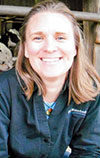How clean is your kitchen? The cleanliness of your kitchen is likely the furthest thing from your mind when you think about cleaning stalls for your dairy cows, but the two areas have a few things in common.
Your idea of a clean kitchen will vary from your neighbor’s, and your tolerance of a dirty one may vary throughout the year. Who can help the flour, sugar and stacks of dishes when you’re making Christmas cookies?
Just as your views on a clean kitchen will vary, so too will each producer’s preferences for clean stalls and clean cows. Those preferences need to be taken into consideration when creating a bedding schedule. The more frequently a barn is bedded and the beds cleaned, the cleaner the cows will generally be. Knowing your preference for stall and cow cleanliness will help you make decisions on a bedding protocol that will help you achieve your ideal conditions.
Your SCC goals
Many operations on the farm influence somatic cell count (SCC), but having dry stalls generally correlates with lower SCC. Commercially available bedding additives may help further reduce bacteria growth and help lower SCC. In deep-bedded stalls, proper attention to scraping at each milking, daily raking and refilling with clean, dry bedding is critical.
Stocking density
Barn stocking density may cause a change in cleaning routines. Overstocking will create more manure in the alleys and additional cleaning will likely be required to help keep stalls dry.
Cow size
In barns with a wide range of cow sizes, rear alignment becomes more difficult. Establishing a regular cleaning routine ensures regular manure removal from the bed surface and helps keep the beds dry.
Alley scraping
The ability to maintain clean alleys may change with the seasons or other factors. You may find a need to increase cleaning and bedding in times when the alleys are unable to be scraped frequently.
Ventilation
Desirable conditions in stalls also depend on proper ventilation. With adequate air exchange, the moisture produced by the animals is removed. The greater evaporation rate associated with drier air results in drier alley surfaces and drier bedding.
Weather conditions
Weather conditions and time of year can influence typical recommended bedding practices. In winter, airflow may be restricted, resulting in a need for more frequent top bedding and bed cleaning. In humid climates, producers often prefer a more frequent application of top bedding, alley cleaning and bed cleaning.
Unknowns
The skid steer never calls in sick, but sometimes gets a flat or doesn’t start at the most inconvenient times. This might throw off your feeding schedule, which throws off your milking schedule, which throws off your bedding schedule. You never know what curve balls are going to be thrown your way, and how you react, adapt and get back on track will all eventually impact the cows in their stall beds.
Have you thought about how some of these other factors are influencing the cleanliness of your stall beds? What are some other considerations that you use to determine your stall bedding routine and schedule? What is one trick you use to stay on schedule? ![]()

-
Amy Throndsen
- Director of Business Development
- Advanced Comfort Technology Inc.
- Email Amy Throndsen





